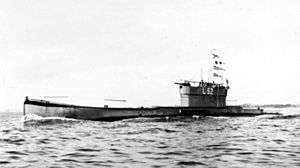HMS L52
 | |
| History | |
|---|---|
| Name: | HMS L52 |
| Builder: | Armstrong Whitworth, Newcastle-Upon-Tyne |
| Laid down: | 16 May 1917 |
| Fate: | Sold for scrap, September 1935 |
| General characteristics | |
| Class and type: | L-class submarine |
| Displacement: |
|
| Length: | 235 ft (71.6 m) |
| Beam: | 23 ft 6 in (7.2 m) |
| Draught: | 13 ft 2 in (4.0 m) |
| Installed power: |
|
| Propulsion: |
|
| Speed: |
|
| Range: | 4,500 nmi (8,300 km; 5,200 mi) at 8 kn (15 km/h; 9.2 mph) on the surface |
| Test depth: | 150 feet (45.7 m) |
| Complement: | 44 |
| Armament: |
|
HMS L52 was a late-model L-class submarine built for the Royal Navy during the First World War. The boat was not completed before the end of the war and was sold for scrap in 1935.
Design and description
L52 and its successors were modified to maximise the number of 21-inch (53.3 cm) torpedoes carried in the bow. The submarine had a length of 235 feet (71.6 m) overall, a beam of 23 feet 6 inches (7.2 m) and a mean draft of 13 feet 2 inches (4.0 m).[1] They displaced 914 long tons (929 t) on the surface and 1,089 long tons (1,106 t) submerged. The L-class submarines had a crew of 44 officers and ratings.[2] They had a diving depth of 150 feet (45.7 m).[3]
For surface running, the boats were powered by two 12-cylinder Vickers[4] 1,200-brake-horsepower (895 kW) diesel engines, each driving one propeller shaft. When submerged each propeller was driven by a 600-horsepower (447 kW) electric motor. They could reach 17 knots (31 km/h; 20 mph) on the surface and 10.5 knots (19.4 km/h; 12.1 mph) underwater. On the surface, the L class had a range of 4,200 nautical miles (7,800 km; 4,800 mi) at 10 knots (19 km/h; 12 mph).[1]
The boats were armed with six 21-inch torpedo tubes in the bow. They carried eight reload torpedoes for a grand total of a dozen torpedoes.[5] They were also armed with two 4-inch (102 mm) deck guns.[2]
Construction and career
HMS L52 was laid down on 16 May 1917 by Armstrong Whitworth at their Newcastle-Upon-Tyne shipyard, launched on 18 December 1918, and completed on 18 January 1921. The boat was sold for scrap in September 1935, but was wrecked off Barry, South Wales.
Notes
References
- Akermann, Paul (2002). Encyclopaedia of British Submarines 1901–1955 (reprint of the 1989 ed.). Penzance, Cornwall: Periscope Publishing. ISBN 1-904381-05-7.
- Colledge, J. J.; Warlow, Ben (2006) [1969]. Ships of the Royal Navy: The Complete Record of all Fighting Ships of the Royal Navy (Rev. ed.). London: Chatham Publishing. ISBN 978-1-86176-281-8. OCLC 67375475.
- Gardiner, Robert & Gray, Randal, eds. (1984). Conway's All the World's Fighting Ships: 1906–1921. Annapolis, Maryland: Naval Institute Press. ISBN 0-85177-245-5.
- Harrison, A. N. (January 1979). "The Development of HM Submarines From Holland No. 1 (1901) to Porpoise (1930) (BR3043)". Submariners Association: Barrow in Furness Branch. Retrieved 19 August 2015.